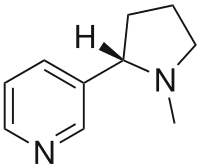
Photo from wikipedia
Pesticides are not only used on food but also on non-food crops, such as tobacco, to control a range of unwanted animal, plant, and microbial, fungal pests. The residue levels… Click to show full abstract
Pesticides are not only used on food but also on non-food crops, such as tobacco, to control a range of unwanted animal, plant, and microbial, fungal pests. The residue levels in tobacco leaves are expected to decline up to harvest, during drying, and when the leaves are further processed. Additional pesticides may also be applied to the finished product and residue levels may remain present even when the tobacco is burned. Human exposure to pesticide residues on tobacco occurs when residues remaining in cigarette smoke are inhaled. Based on this assumption, the objectives of this research were (i) to determine the level of pesticides residues in harvested tobacco leaves and (ii) to assess the risk of human exposure to these residues in tobacco smoke. Pesticide residues were detected in all analysed tobacco samples. These detected residues represent ten different active ingredients (AI), three of these AIs (thiodicarb, alachlor, and endosulfan) are no longer allowed in Europe. A 54.7% of these residues were quantifiable. Furthermore, it was found that with the use of solid-phase extraction sorbent (SPE) as adsorbent and n-hexane as solvent, higher recoveries of the pesticide residues in the tobacco smoke from the amount spiked can be obtained. It was also found that cigarette filters help to reduce the intake of residues of pesticides that may be present in cigarettes. Finally, the study concluded that both active smoking and passive smoking populations are exposed to pesticide residues in the tobacco smoke.
Journal Title: Environmental Monitoring and Assessment
Year Published: 2020
Link to full text (if available)
Share on Social Media: Sign Up to like & get
recommendations!